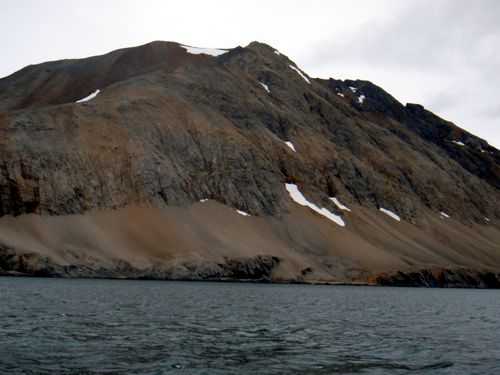Polish TV recently showed the farewell concert of Monty Python and "The bright side of life" (my Polish is still extremely limited, but I could understand that much ...) (especially the English part ...) For the last 24 hours, the sun has been shining and I can see its bright rays illuminating the glaciers and moraines on the other side of the bay of Isbjornhamna. Today, we are going to do experiments in the deepest parts of the fjord, and sail there for a large part of the day. We launch our boat shortly after another party of scientists has left for the fjord of Hans Glacier. Amongst them is a friend and former Bath postdoc, Aleksandra Kruss. A multibeam sonar expert with an international reputation, she is out there to test the latest generation of high-resolution sonar in this challenging environment. She also kindly agreed to take measurements of the front of the glacier, to help us in our interpretations. She has extensive Arctic field experience so we know she won't get too close to the glacier for safety, but the sonar should do an excellent job at mapping what it looks like underwater.

In the meantime, we move to a slightly different type of landscape: very eroded mountains, and much less green. No moss, no lichen visible from the boat: no animals either. The Polar Station has disappeared at the horizon: even finding the peak below which it stands, we cannot see it. The ride to the other side of the bay took us 40 minutes, bumping into the waves on our small Bombard C5. After 20 minutes of measurements, we realise the site is not suitable, and move to a different location, on the original side of the bay (another 40 minutes, bumping into the waves, making sure we fall back into the boat and clinging tightly to the ropes ...). There, we can make the right kind of measurements. We also understand why no one had ever made this before: it's hard, it's cold, and we have to do several trials and use our field knowledge of underwater acoustics before getting it right ... After many hours drifting in the cold wind and short waves, we have all the results we want and head home. Cold to the bones (it takes me until this evening to warm up, despite the many layers of clothes), but delighted with the results. Which we start analysing immediately after cleaning the equipment, untangling several hundred metres of cables and of course manhandling the boats back on shore (Aleksandra and her colleague are back too: but their boat is fortunately lighter, or maybe it's the fact we are now 5 people hauling it ...)
Respond